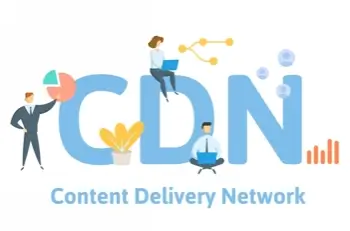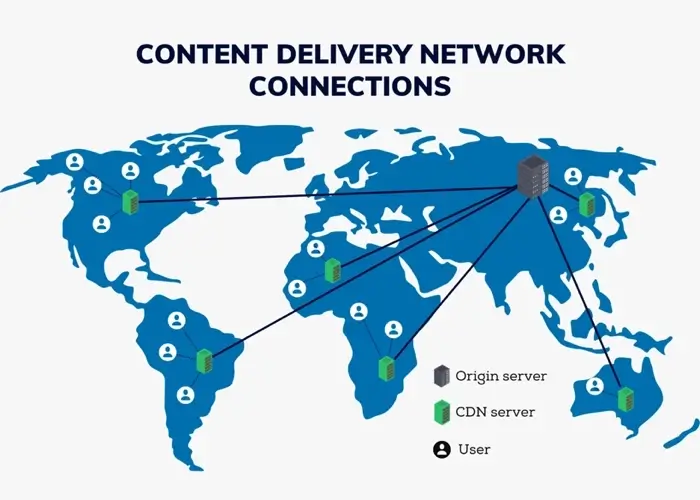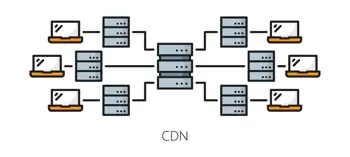What Is a CDN (Content Delivery Network)?
As the digital marketing landscape changes, users need a better way to deliver content online. Sites want to serve content to visitors with minimal downtime and high-traffic sites like Facebook and Amazon need to ensure all users get access to their content hassle-free. Thanks to the content delivery network market, which is quickly growing, this is possible. In this article, we'll cover what a content delivery network (CDN) is, why it's relevant, and why it's needed to accelerate content delivery to visitors.
What is a content delivery network?
A content delivery network (CDN) is a group of geographically distributed servers designed to provide faster Internet connections to users in their geographical locations. The tool accomplishes this by offering several points of presence (PoPs), or data centers, outside the original server. The more points of presence there are, the better the coverage.
At its most basic level, a CDN brings a copy of web content closer to where users live regardless of their location with data centers.
To understand content delivery network architecture, understand these few key terms:

- Points of presence - Also known as edge servers, these refer to the data centers or the number of locations that a CDN offers globally.
- Origin servers - These computers store the original version of your website files, such as your web host.
If you run a website, CDNs help speed up your site's page load times. Whether you're familiar with it or not, almost everyone interacts with CDNs daily - when browsing social media platforms or Internet content, reading articles on news sites, watching YouTube videos, or shopping online.
How does a content delivery network work?
A content delivery network (CDN) works by delivering static content to servers located closest to where users are surfing online. The edge servers deployed in different locations are tasked with keeping a cache copy of your website's files, which includes:
- images and videos
- CSS, HTML JavaScript files
- stylesheets
- text, graphics, and documents
- applications
It also includes any other files that comprise a website. The distribution content delivery network edge servers work on the principles of caching, dynamic speed and acceleration alongside edge logic computations.
When visitors request static website resources, the CDN retrieves these resources from the primary server. Then, the copy of resources is cached and stored in the nearby edge server. This cached data will be used for the user's future requests.
Consider, for example, one user in the USA and another in London who both want to visit a website hosted in Canada. Both users must send a request to the original server in Canada. Then, going forward, the origin server will send website content from Canada to the US and London.
Visitors outside the site's primary source have to wait longer for a webpage to load. The further the distance between an origin server and an end user, the longer it takes a website to respond. Here, content delivery networks become relevant. The edge servers located on points of presence spread worldwide alleviate latency.
Whether users come from the Americas, Europe, Asia, Africa, or Australia, content is automatically served from nearby locations whenever possible. As a result, users experience lower loading times, reduced bandwidth consumption, and improved security.
What's the primary purpose of CDN?
A content delivery network's main purpose is to reduce latency. Measured in milliseconds, latency is essentially the time it takes for data packets to travel from one point to another over the Internet. Therefore, the lower the latency, the faster the user's browsing experience.
When site visitors find it takes them longer to connect to a specific web server, they may abandon a slow-loading site. The perceived delay in processing data is the issue CDNs are designed to solve.
Higher latency negatively impacts not only page load times but also user experience. Keep in mind that the delay interval can vary depending on external factors as well.
One obvious factor is the physical distance between your website's hosting server and the end user. CDNs aim to shorten that physical distance, which in turn improves site rendering speed. CDNs are tied to almost all content consumed on the web.
For website creators, they can choose a top-tier web hosting service, optimize their images, and install cache plugins, but all of those things still aren't quite enough. Use them in conjunction with a content delivery network to boost a website's overall performance.
While the benefits of a CDN are many, they don't eliminate the need for a good web host or similar middleware. Web hosts are responsible for storing a site's original files; a content delivery network simply caches a copy of the files.

Benefits of using a content delivery network
Everyone who browses the web has already experienced the benefits of a CDN - from content creators and end users to network service providers. It's clear why most web hosting providers find it necessary to run their own CDNs to meet their customer's needs. Most of them provide CDN services as an add-on.
Here are the benefits you get from this mass-market technology.
Improved website load times
Consistent user experience matters, and that includes speed. Low speeds hamper user experiences; CDNs speed up sites while lowering network latency.
As users are inclined to leave sites with high latency and long loading times, CDNs help keep visitors on-site by providing minimal delay. Furthermore, your website won't be vulnerable to crashes, even during sudden spikes in traffic at the point of origin.
Content delivery networks also improve content delivery by reducing file sizes to match better load speeds and optimizing server architecture to handle a large number of users.
Reduced bandwidth costs
Users consume network bandwidth whenever a website responds to users' requests. Bandwidth cost is an expense for every business. Through caching website files, CDNs reduce the data an origin server has to deal with, thus reducing hosting costs for maintaining a website.
Increased content availability
The main goal for creating high-converting content is to reach users everywhere. But things can go wrong – the network becomes congested, origin servers go down, hardware fails, or connections get disrupted. All of these interrupt how your website functions.
Availability means your content should be accessible to your targeted audience even when there's a sudden surge in traffic. In the face of this disruption, a collection of distributed servers can help handle the incoming traffic way better than origin servers. If for any reason one CDN edge server in the data centers crashes, other operational servers can take up the mantle to keep the service alive.
Enhanced website security
Another underrated benefit of a content delivery network is the security it provides. A successful site will likely experience attacks at some point in time. Most distributed denial-of-service (DDoS) attacks are directed towards websites, leaving them vulnerable to hacking.
The CDN technology is well-suited to mitigate these DDoS attacks. With many proxy servers, a content delivery network can absorb unnatural web traffic. Essentially, CDNs create a buffer between the original server and users, shielding the origin's real IP from malicious actors.
Better SEO rankings
Page speed is a ranking factor for Google's search results. In May 2021, Google rolled out the Core Web Vitals update to capture the end-user experience.
It assessed loading (LCP), interactivity (FID), and scalability. Therefore, making your webpage load faster is paramount in the eyes of Google.
CDNs help achieve this by boosting your website's speed. Better website uptime is at the center of ranking search results.
What is a CDN used for?
In addition to focusing on website performance, a CDN increases customer satisfaction. Here's what content delivery networks are used for:
- Seamless content delivery. People make use of CDNs to provide their customers with static content during busy times. It doesn't rely on satellite-link communication and provides fast, easy delivery.
- Real-time streaming. Major streaming companies use content delivery networks to reliably deliver high-quality audio, videos, documentaries, and other media files. CDNs help overcome three challenges: delivery time, bandwidth costs, and scale. Hulu, for example, uses Amazon CloudFront to stream massive amounts of data to millions of global users.
- Mobile apps and SaaS. Mobile application providers use CDNs to accelerate dynamic content delivery in the shortest possible time. The network increases response time, reduces load times, and improves mobile users' experiences.

Who uses content delivery networks?
Almost everyone who uses the Internet uses content delivery network companies. They reduce the time needed to send, process, and deliver content to users, so all parties benefit.
Content delivery networks for content and application owners
Content and application owners use CDNs for several reasons: quick transfer of content to users, increased reliability, and better user experience. Even mid-sized website owners should choose hosting with a CDN.
Any website using a content delivery network can better manage its traffic by handling user requests more efficiently.
Content delivery networks for website visitors
Website visitors, also known as end users, experience faster page loads with content delivery networks regardless of their geographical location. However, the vast majority don't know they're connecting through a CDN as they enjoy its benefits.
Content delivery networks for network service providers
Another group of people who get the most out of content delivery networks are network operators. The exponential growth of online streaming has driven network service providers to establish their own CDNs so as to reach customers regardless of location.
A content delivery network helps meet increased user expectations about high performance on the web across multiple devices. It reduces web traffic on the origin server, reduces subscriber churn, and so on.
Content delivery networks for E-commerce businesses
Big E-commerce organizations like Amazon use proxy servers to deliver content to all users, especially when traffic spikes are likely.
Features of a content delivery network
For a CDN to accelerate content delivery - script files, webpages, images, and other files - it uses the following features.
- Security and DDoS protection - Web content is vulnerable to unusual traffic, malware, and other cyberattacks. CDN providers need stringent security measures.
- A global reach - CDNs provide edge servers across the world to ensure that the connections are fast and reliable.
- Low latency - Latency is the time data takes to process and reach the end user. A CDN minimizes latency interval by storing content near the user geolocation.
- SSL security - This is the HTTPS service. A content delivery network service should provide users with an SSL certificate, which keeps visitors' data safe and helps a website build trust among users.
Content delivery network pricing varies; make sure you find a network that meets your needs at the best price for you.
Frequently asked questions
What is an origin server?
An origin server is a computer that stores the original version of your website files.
What are CDN edge servers?
Content delivery network edge servers are computers that cache a copy of content retrieved from an origin server.
What is the difference between DNS and CDN?
CDNs work in conjunction with the domain name system, or DNS, to cache content at DNS caching servers. Then, these together increase delivery speeds from source to user. Whereas a CDN uses edge servers to deliver static content closer to users, the domain name system maps domain names to IP addresses, which is a completely different service.
What are the two types of content delivery network?
There are two types of content delivery network: public and private. Operators manage public CDNs based on a pay-per-use model. The more content that passes through the CDN, the more money owed to the provider. With private CDNs, you pay upfront for hardware and must manage your own servers, but users don't need to pay for traffic that goes through the servers.
What is a CDN example?
An example of a content delivery network is Cloudflare and their associated services.
How is CDN different from web servers?
Content delivery networks and web servers both support web connections and infrastructure, but they serve different purposes. Web servers are necessary for hosting websites; they serve content directly to users. Content delivery networks, on the other hand, act as a middleman to deliver content to a company or website depending on its performance and size.